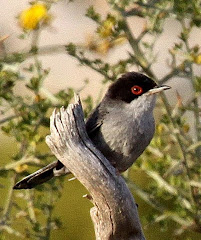The White-tailed Lapwing which arrived at the Seaforth Docks Nature Reserve near Liverpool yesterday created considerable interest. This is only the seventh record for Britain and probably only the fifth actual bird. The last one was seen at Caerlaverock in 2007 before later moving to Leighton Moss for a short while. They nest in south central Asia, after which some migrate south to the Middle East and north-east Africa. This one was therefore a very long way from home.
Within the docks area security is strictly applied and only those with special permits are allowed inside the perimeter. The fortunate ones there today must have had exceptional views as the bird spent most of the morning at the edge of the lake, often within 20 metres of the main hide.
.jpg)
[Long range photo of the hide and the fortunate photographers. The bird sometimes fed amongst the stones directly under the hide]
Otherwise, the only viewpoint was from outside the 10 ft high metal perimeter fence which runs alongside the marine lake. From there the bird was at a distance of at least 250 metres with the shimmering haze over the water not helping viewing. Seen from this angle it was mostly obscured behind vegetation. However, in almost a regular ritual, it would emerge and move across the front of the hide, feeding all the time. Then after a couple of minutes it would retrace it steps and be hidden again for a while before re-emerging to repeat the process.
.jpg)
[View from the fence. The bird was on the far shore of the lake and often directly in front of the hide (centre far distance, beyond the tern rafts)]
Although viewed at a long distance its fawn coloured back and long pale legs could still be seen. When occupying a photogenic position in front of the hide, the clatter of the camera shutters could be heard even from outside the fence, so that the bird would scurry away again out of sight.
.jpg)
.jpg)
[Apologies! Photographs were spoilt by the great distance and the heat haze distortion over the water. However, the bird can just be made out dead centre in both photos. In the lower photo it was feeding on the small shingle spit (pale object between the two small boulders)]
Watchers arrived from far and wide and took up what they considered to be optimimum positions on the sand bank outside. None of the viewpoints could be described as very satisfactory, though.
.jpg)
[Groups of watchers outside the fence]
For excellent close photos taken yesterday by Bill Aspin from the hide, see:
http://babb2.blogspot.com/
PS: BirdGuides reported the bird absent early the following morning (29th). One, however, had turned up near Haarlem (Netherlands), could it be the same bird?
.jpg)
.jpg)
.jpg)
.jpg)
.jpg)
.jpg)
.jpg)
.jpg)
.jpg)
.jpg)
.jpg)
.jpg)
.jpg)
.jpg)
.jpg)
.jpg)
.jpg)
.jpg)
.jpg)
.jpg)
.jpg)
.jpg)
.jpg)
.jpg)
.jpg)
.jpg)
.jpg)
.jpg)
.jpg)
.jpg)
.jpg)
.jpg)
.jpg)
.jpg)
.jpg)
.jpg)
.jpg)
.jpg)
.jpg)
.jpg)
.jpg)
.jpg)
.jpg)
.jpg)
.jpg)
.jpg)
.jpg)
.jpg)



